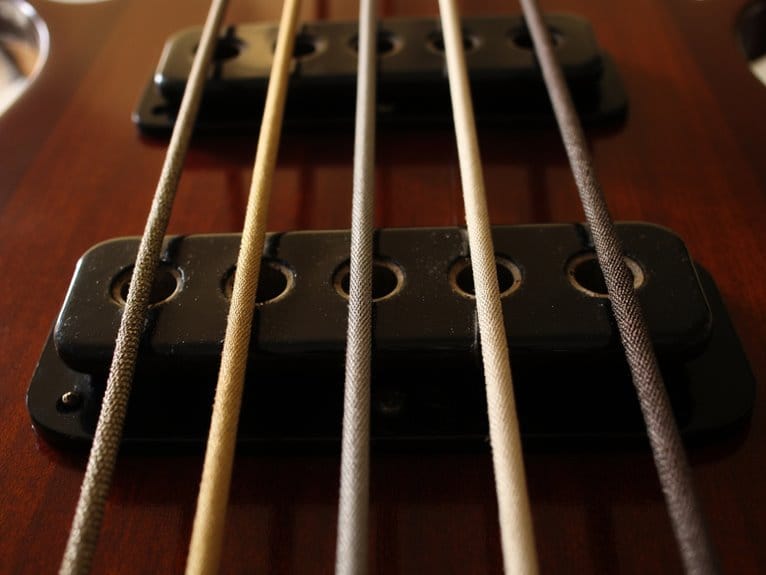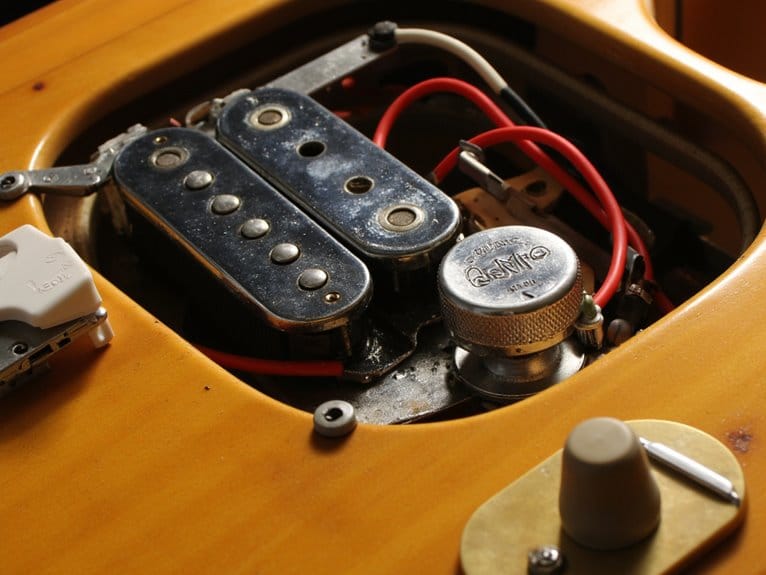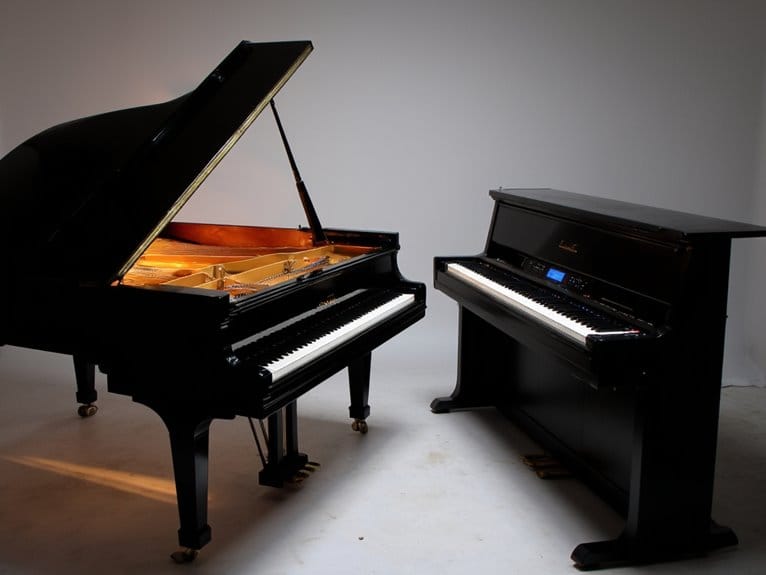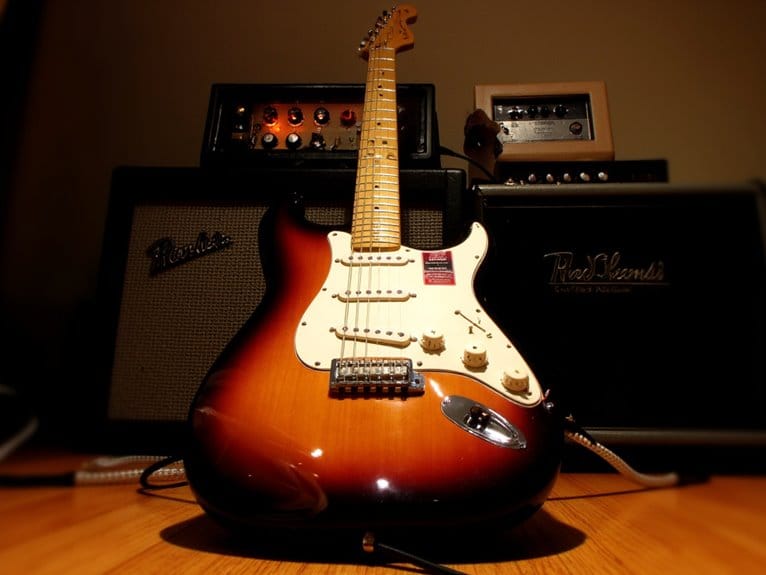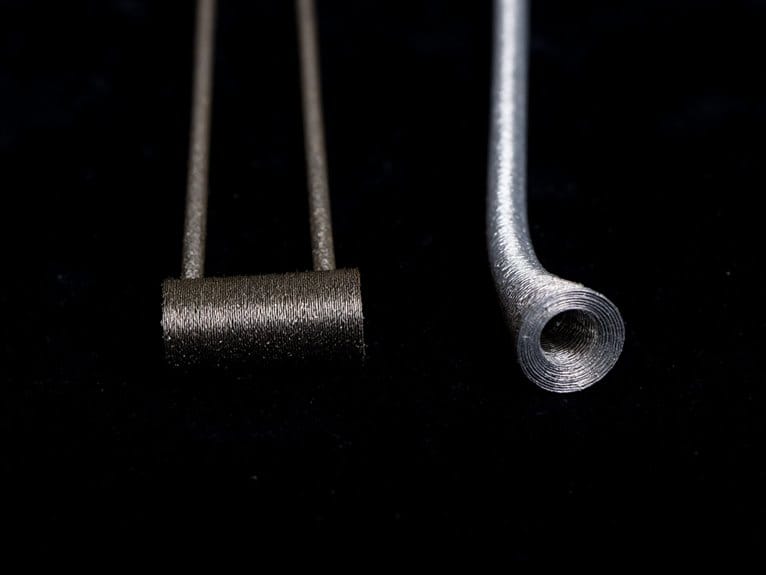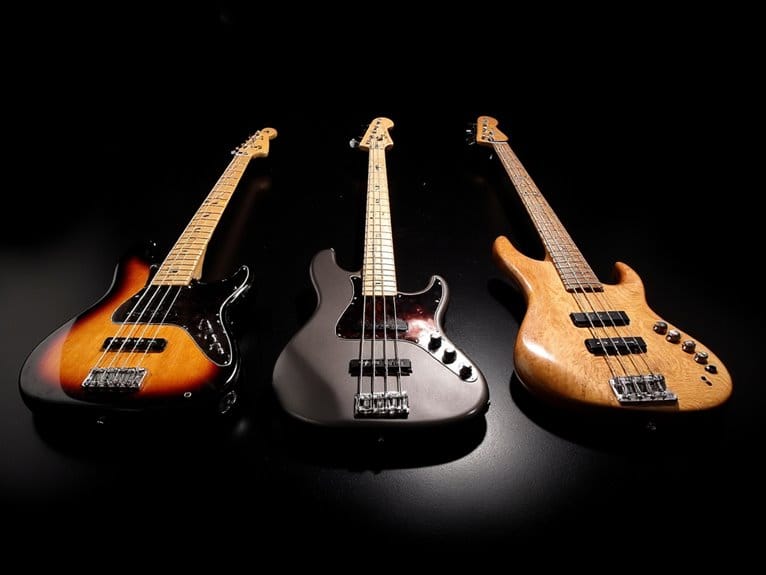How to Choose Bass Strings for Different Playing Styles
Choose bass strings by matching winding type to your style: flatwounds deliver smooth warmth for jazz, while roundwounds provide bright attack for rock and slap techniques. You’ll want heavier gauges (.045-.105 or thicker) for aggressive playing and drop tunings, lighter strings for extended fingerstyle sessions. Material matters too—nickel offers vintage warmth, stainless steel brings aggressive brightness, and cobalt enhances dynamic range. Below, we’ll explore the specific techniques that’ll help you dial in your perfect tone.
We are supported by our audience. When you purchase through links on our site, we may earn an affiliate commission, at no extra cost for you. Learn more.
Notable Insights
- Fingerstyle players should choose medium gauge flatwounds or half-rounds to reduce finger noise while maintaining clarity and warmth.
- Slap bass techniques require heavy gauge roundwound stainless steel strings for crisp attack, brightness, and durability against aggressive playing.
- Jazz and vintage styles benefit from flatwound nickel strings that provide smooth surfaces and exceptional tonal warmth.
- Metal and aggressive genres need stainless steel roundwounds or cobalt strings for enhanced brightness, dynamic range, and cutting power.
- Extended playing sessions call for lighter gauge strings to reduce finger fatigue while maintaining proper articulation and responsiveness.
Understanding String Types and Their Tonal Characteristics
The foundation of any great bass tone starts with understanding the fundamental differences between string types, and honestly, I’ve learned this lesson the hard way through years of trial and error with various setups.
Your choice between flatwound, roundwound, half-round, and tapewound strings dramatically affects your sound’s character.
Flatwound strings deliver smooth surfaces with exceptional tonal warmth, making them perfect for jazz and vintage styles, while roundwound strings provide bright, punchy tones through their textured string winding that enhances attack and sustain.
Half-rounds split the difference, offering smoother feel while retaining clarity, and tapewounds use flat tape strips for maximum warmth with minimal brightness, ideal for upright bass emulation and fingerstyle playing. The specific winding type you select also impacts your playing technique preferences, whether you favor fingerstyle, slap bass, or pick playing.
The string gauge you choose will significantly influence both tone quality and playability factors across all these string types.
Matching String Gauge to Your Playing Technique
Once you’ve settled on the right string type for your tonal goals, selecting the proper gauge becomes equally important for optimizing your playing technique and comfort.
Standard gauges like .045–.105 provide versatile tension balance for most styles, though your personal preference ultimately determines the best choice. If you’re into aggressive slapping or metal picking, heavier gauges deliver the snap and clarity you need without sacrificing durability.
Jazz players and fingerstyle enthusiasts often gravitate toward lighter strings for enhanced articulation and reduced finger fatigue during extended sessions. Lighter gauges also offer improved agility for complex fingerstyle playing techniques, making them particularly well-suited for fretless bass applications.
Scale length affects this equation considerably—longer necks require heavier gauges to maintain proper tension, while short-scale basses work better with lighter strings to preserve intonation and clarity. Players who frequently use drop tuning should consider upgrading to heavier gauge strings to maintain proper string tension and avoid floppiness.
Your choice of string gauge can also impact how well your bass bridge transfers energy and sustain, particularly if you’re using a high-mass bridge that’s designed to enhance resonance and string stability. The body material of your bass guitar also influences how different string gauges will resonate, with mahogany bodies providing warmer tones and enhanced sustain that can complement heavier gauge strings.
Material Choices for Genre-Specific Sound
Material composition dramatically shapes your bass’s voice, and I’ve found that matching string materials to specific genres can make the difference between blending into the mix and commanding attention.
When comparing nickel vs stainless steel, nickel delivers warmer, vintage tones perfect for rock and jazz, while stainless steel provides aggressive brightness ideal for metal and punk styles.
Cobalt advantages include enhanced dynamic range and improved magnetic properties, making them excellent for fusion and progressive genres requiring versatility.
Copper characteristics blend electric brightness with acoustic warmth, enhancing midrange presence for folk and country applications.
For acoustic considerations, copper-plated strings offer superior clarity and projection, while flatwound options provide smooth feel with mellow sound preferences.
Nickel-plated steel construction offers an excellent brightness-warmth balance that works particularly well for versatile performance across multiple genres like rock, blues, and fingerstyle playing.
The clarity and brightness of your string material choice becomes even more important when using 3-band EQ systems to shape your tone for different musical styles.
Quality oxygen-free copper conductors in your signal chain complement premium string materials by preserving the tonal characteristics you’ve carefully selected for your playing style.
Optimizing String Selection for Different Bass Techniques
Every bass technique demands its own string personality, and I’ve discovered that matching your playing style to the right string characteristics can transform your performance from adequate to exceptional.
If you’re developing finger strength for aggressive slap techniques, heavy gauge roundwounds with stainless steel construction provide the tension effects necessary for crisp attack and sustain, though they’ll challenge your fretting hand initially.
For intricate fingerstyle work, I prefer medium gauge flatwounds or halfwounds that reduce finger noise while maintaining clarity.
Your technique choice directly influences string longevity—slap players burn through strings faster due to increased friction, making coated options worthwhile investments. Coated strings provide an extended lifespan overall, improving resistance to corrosion and environmental factors.
Aggressive playing styles accelerate string wear significantly, making coated strings essential for players prioritizing longevity over frequent replacements.
When upgrading your instrument, consider that pickup configurations like P-J setups work synergistically with different string types to enhance your bass’s tonal versatility across various playing techniques.
High-output pickups can particularly benefit from strings that complement their enhanced bass presence, creating powerful performances that cut through dense band mixes.
The key lies in balancing playability with tonal requirements, ensuring your strings enhance rather than hinder your technical expression.
Setup Considerations When Changing String Types
When you swap string types on your bass, I’ve learned the hard way that your instrument’s setup becomes about as accurate as a weather forecast—which means you’re in for some adjustments. Different string gauges affect neck tension dramatically, requiring truss rod adjustments to maintain proper relief, while action height needs recalibration since thicker strings sit higher off the fretboard.
| Setup Element | Heavy Gauge Impact | Light Gauge Impact |
|---|---|---|
| Neck Relief | Requires loosening truss rod | Needs tightening truss rod |
| Bridge Height | Raise saddles for clearance | Lower for ideal playability |
| Intonation | Move saddles back typically | Adjust forward usually |
I’ve found that intonation suffers most when changing materials—coated strings stretch differently than nickel rounds, throwing your 12th-fret harmonics completely out of whack until you dial everything back in. The hex-core construction found in many modern string sets provides enhanced sustain and brightness compared to traditional round cores, but may require different pickup height adjustments due to their magnetic properties. Quality bass tuners with higher gear ratios become essential during this process, as they provide the precision needed for fine adjustments when recalibrating your instrument’s intonation and overall tuning stability. Many players also benefit from monitoring their signal integrity during string changes, as different string materials and construction can affect the clarity of your bass signal through your preamp or direct recording setup.
Frequently Asked Questions
How Often Should I Change My Bass Strings?
You should change your bass strings every 3-4 months with moderate playing. Follow frequency guidelines based on your playing style and tone preferences. Regular string maintenance tips like cleaning can extend their lifespan considerably.
On a final note
You’ve got the knowledge now to match your strings to your playing style, whether you’re laying down precise fingerstyle jazz lines with flatwounds or attacking aggressive rock riffs with bright roundwounds. Remember, there’s no universal perfect string—what works for your neighbor’s slap technique might muddy your fingerpicking tone. Don’t be afraid to experiment with different gauges and materials until you find that sweet spot where your bass truly sings.

